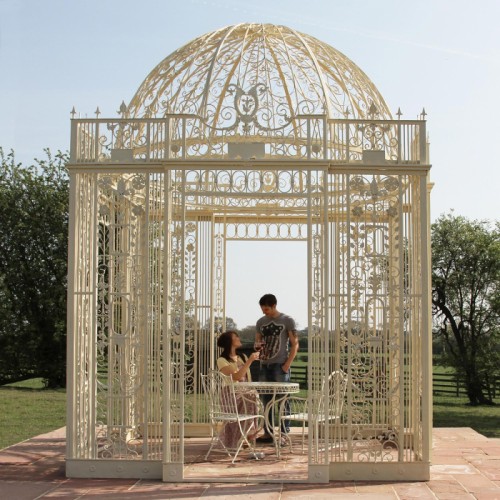Modern gazebos are a gift from the past. They were invented by the ancient Egyptians some 5,000 years ago. But throughout history, different cultures and civilisations have used and adored these ornamental structures.
The Egyptians placed gazebos in their ornamental gardens to grow grapevines and flowers, and Prosperous Persians used them as a workspace.
For the Romans and Greeks, gazebos were a place for relaxation. In Asia, gazebos were used as pavilions, temples, and tea houses.
It wasn’t until the Middle Ages (5th to 15th century) that gazebos became popular in Europe. They were featured in private gardens as well as public spaces for rest and shelter. In the 18th century, gazebos arrived in America, too.

An intricately detailed pagoda. Credit: Shutterstock
Today, gazebos are springing up in landscapes all over the world. Whether you have a gazebo already or plan to get or build one, knowing a bit about the history of gazebos will help you appreciate yours even more.
Why is it called a gazebo?
Gazebos are an ancient piece of architecture. But their name is an 18th-century invention. It first appeared in 1752 in John and William Halfpenn’s architecture book titled ‘New Designs for Chinese Temples’.
The term ‘gazebo’ comes from a comical mix of the English word ‘gaze’ and the Latin ending ‘ebo’ meaning ‘I shall.’ That is, ‘I shall gaze.’ True to its name, a gazebo provides the perfect place to relax and enjoy the pleasant views around it.
The history of gazebos
Gazebos or gazebo-like structures have dotted ancient landscapes around the world. They have stood the test of time, gracing modern gardens just as well.
Let’s take a closer look at their history, from Ancient Egypt to Rome, Greece, Asia, and more.
Gazebos in Ancient Egypt
Historians believe that the first gazebos were built over 5,000 years ago in Egypt. No remains of Egyptian gazebos were ever found. But murals over ancient tombs depict structures similar to the modern gazebo we know today.
The Egyptians thought of their gardens and gazebos as earthly paradises that they could take to the afterlife. As you may have guessed, members of royalty were the first to have them. A layout of the garden would be depicted in their tomb to help the gods recreate it.
Egyptian gazebos were commonly made of sandstone and timber. They were built near a body of water and adorned with vines and ornamental plants. They were used as a place to get shade and relax.

There may be no remains but you can still enjoy the Egyptian scenery under a gazebo. Credit: Shutterstock
Gazebos in Persia
Persian gazebos were magnificent. They were generally built near ponds or waterways and decked with flowering vines. These gazebos also doubled as workspaces to welcome dignitaries and important guests.
The Persians built many different types of gazebos, from colourful tents and timber-framed structures to two-story marble gazebos with cupolas. But Persian gazebos were often a sign of affluence, enjoyed only by the wealthy classes.

Persian style gazebo. Credit: Shutterstock
Gazebos in Ancient Rome and Greece
Unlike us, the Ancient Greeks did not own private gardens—all their gardens were public. They built gazebos in spaces around their temples, so they regarded them as sacred.
Greek gazebos were generally made of marble and other natural stones. They were a smaller version of the main temple dedicated to the gods. The Greeks used them as a place to socialise or to discuss philosophy.

Greek-style gazebo. Credit: Shutterstock
Romans, on the other hand, owned private gardens. Their gazebos were similar in style to those of Ancient Greece. But they were mostly used for relaxation and entertainment.
Roman gazebos were surrounded by ornamental plants. They were enjoyed by the common and the wealthy alike.
Gazebos in Asia
Asian gazebos bring to mind a very serene image. And rightly so. In China and Japan, gazebo-like structures were used for mediation and quiet contemplation. They were also a part of the temples, allowing the devotees to pray in peace.
In China, gazebos were quite elaborate. They were round structures featuring ornate roofs and decorative timber carvings. Like other Chinese constructions, these gazebos were often earthquake-proof.

Asian-style gazebo. Credit: Shutterstock
Japanese gazebos were simpler in structure and design. They were used to host the traditional Tea Ceremonies. As a result, they were carefully designed and spotlessly maintained. These gazebos were often an important feature of peaceful rock gardens.
Gazebos in Europe
In Europe, gazebos found popularity during the Middle Ages. They first came to France in the 14th century, when four gazebos were built at the Louvre in Paris. This spiked their popularity in many other European countries.
In Elizabethan gardens, gazebos were built after the main house. And they were commonly used for entertaining guests. These gazebos were made of wood, steel, iron, or glass, and varied greatly in design.

Elizabethian-style gazebo. Bohemian Baltimore, CC BY-SA 4.0, via Wikimedia Commons
Later in the 18th century, many European countries got caught up in a craze for oriental-style summerhouses. Many of these summerhouses were simple gazebo-style buildings.
Gazebos in America
Gazebos came to the US pretty late, only around the 18th century. But they quickly gained popularity with the rise of the middle, prosperous class.
They fell out of favour for a bit, but made a quick return in the 20th century. Ever since, gazebos have been gracing the gardens and parks across America.
Gazebos today
Gazebos remain very popular around the world. While they usually retain the airy grace and studied simplicity of their precursors, they are more adaptable than ever to your whims and fancies.
You can opt for an octagonal or rectangular, ornate or plain, large or small, elegant or rustic gazebo. Basically, anything you can dream up.

Contemporary gazebo
Modern gazebos can also house a spa or a hot tub. What’s more, gazebos are no longer a privilege only for the prosperous. They are modestly priced and can fit in just about anyone’s garden.
Today, you can buy a gazebo ready-made and install it within a few hours.
The evergreen gazebo
Gazebos have long been in fashion, whether we’re talking about Egyptian paradises, Roman summerhouses, Asian tea houses, or ornate Persian gardens.
Evergreen and dependable, the modern gazebo has many different uses. You can read and relax in it, turn it into an outdoor spa, serve food in it, or use it as a vantage point for gazing at the beautiful nature around you. Your gazebo will offer you shade and privacy throughout the year.
You can also take inspiration from Asian gazebos. Use your space to meditate and connect more deeply with your spiritual self.
Even if they may not all be unique, modern gazebos remain a wonderful and convenient garden feature. One that’s likely to stay with us for many years to come.

Save this pin for later






